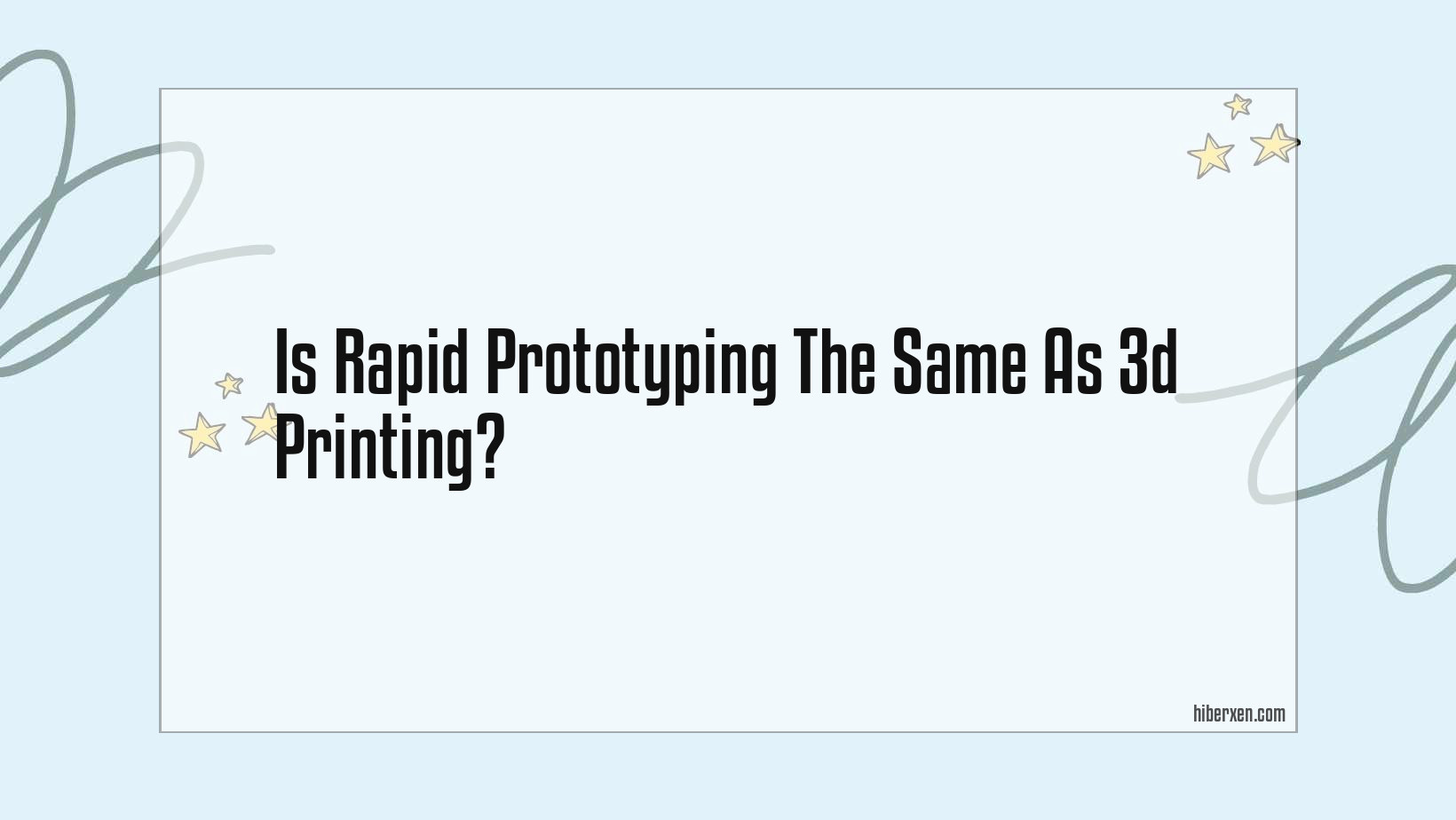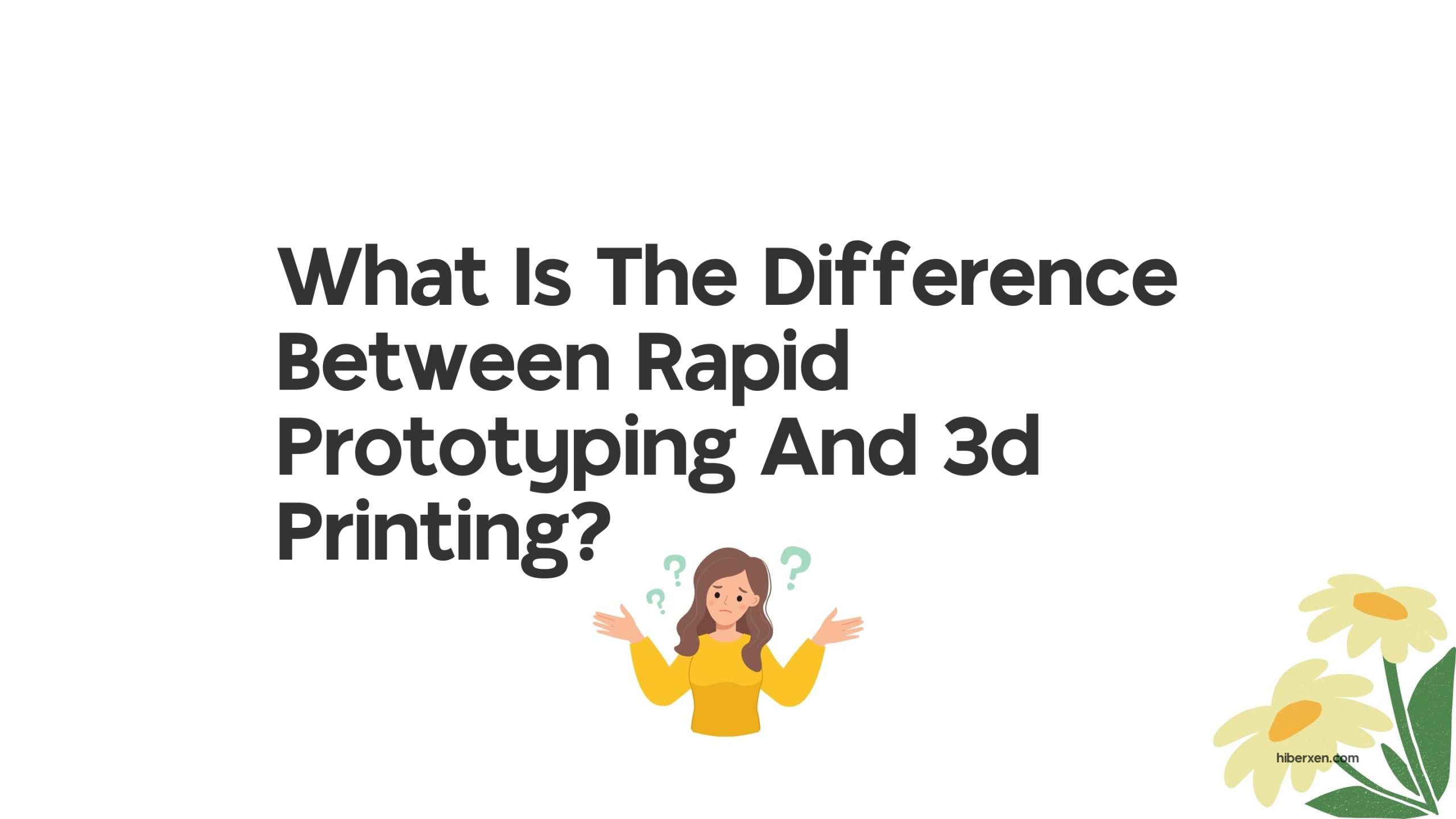No, rapid prototyping is not the same as 3d printing.
Yes, rapid prototyping and 3D printing are the same thing. Both terms refer to the process of quickly creating a three-dimensional model of a product or object using a computer-aided design (CAD) program. This model can then be used to create a physical prototype using a 3D printer.
Rapid prototyping is a powerful tool for product development and can be used to create prototypes of just about anything, from medical devices to car parts. 3D printing is an increasingly popular method of rapid prototyping, as it is relatively quick and easy to set up and use.
There are a few key differences between rapid prototyping and 3D printing. Firstly, rapid prototyping generally refers to the creation of a prototype using any method, while 3D printing specifically refers to the use of a 3D printer. Secondly, rapid prototyping is often used to create functional prototypes, while 3D printing is more often used to create visual prototypes.
However, at the end of the day, both rapid prototyping and 3D printing are incredibly useful tools that can be used to bring products and ideas to life quickly and easily.
What Is The Difference Between Rapid Prototyping And 3d Printing?
Rapid prototyping is a process where a three-dimensional model is created from a CAD file. 3D printing is a process of making a three-dimensional object from a digital file.
In the world of product development, there are many different ways to create a prototype of your product idea. Two popular methods are rapid prototyping and 3D printing. Here’s a look at the key differences between these two methods:
Rapid prototyping is a process of creating a three-dimensional (3D) model of a product idea using a specialized machine. The machine creates the model by depositing successive layers of material, typically plastic, according to a computer-generated design.
3D printing, on the other hand, is a process of creating a 3D model of a product idea using a printer. The printer creates the model by depositing successive layers of material, typically plastic, according to a computer-generated design.
So, what’s the key difference between these two methods? Rapid prototyping is typically faster than 3D printing. That’s because the specialized machine used for rapid prototyping can deposit material faster than a printer.
Another key difference is that rapid prototyping can create more complex models than 3D printing. That’s because the machine can deposit material in a more precise way than a printer.
So, if you need a prototype quickly and you don’t need a complex model, 3D printing might be the best option. If you need a prototype quickly and you need a complex model, rapid prototyping might be the best option.
Here’s a real-life example. Let’s say you’re designing a new cell phone case. If you just need a basic prototype to test the fit of the case, 3D printing might be the best option. But if you need a prototype to test how the case feels in your hand, rapid prototyping might be the best option.
What Are The Benefits Of Rapid Prototyping Over 3d Printing?
Rapid prototyping is faster and cheaper than 3d printing.
Rapid prototyping is a process where a three-dimensional model of a product is created using additive manufacturing techniques. This allows for the quick creation of prototypes, which can then be used for testing and evaluation.
3D printing is a process where a three-dimensional object is created by laying down successive layers of material. This can be done using a variety of different materials, including plastics, metals, and ceramics.
Rapid prototyping has several advantages over 3D printing. First, it is much faster. This is because the process of creating a prototype using rapid prototyping is much simpler than the process of creating a 3D-printed object. Second, rapid prototyping allows for more accurate prototypes. This is because the process of creating a prototype using rapid prototyping is more controlled, and the final product is less likely to have defects. Finally, rapid prototyping is less expensive than 3D printing. This is because the process of creating a prototype using rapid prototyping requires less material, and the final product is typically of a higher quality.
What Are The Benefits Of 3d Printing Over Rapid Prototyping?
3D printing is faster, easier, and more accurate than rapid prototyping.
When it comes to bringing your product designs to life, you have a few different options available to you. Two of the most popular methods are 3D printing and rapid prototyping. But which one is right for your project? In this blog, we’re going to compare 3D printing vs rapid prototyping, so you can make an informed decision about which technology is best for your needs.
What is 3D Printing?
3D printing is a manufacturing process that creates three-dimensional objects from a digital file. It’s also known as additive manufacturing because it builds up an object by adding layer upon layer of material.
There are a few different technologies that can be used for 3D printing, but the most common is fused deposition modeling (FDM). This process involves extruding a thin layer of melted plastic onto a build platform. The platform lowers and the process repeats until the object is complete.
Other popular 3D printing technologies include stereolithography (SLA) and selective laser sintering (SLS).
What is Rapid Prototyping?
Rapid prototyping is a manufacturing process that creates three-dimensional objects from a digital file. It’s also known as additive manufacturing because it builds up an object by adding layer upon layer of material.
There are a few different technologies that can be used for rapid prototyping, but the most common is stereolithography (SLA). This process involves curing a layer of photopolymer resin with a laser beam. The platform lowers and the process repeats until the object is complete.
Other popular rapid prototyping technologies include fused deposition modeling (FDM) and selective laser sintering (SLS).
3D Printing vs Rapid Prototyping: The Differences
Now that we’ve explained what 3D printing and rapid prototyping are, let’s take a look at the key differences between these two technologies:
1. Speed
When it comes to speed, 3D printing is the clear winner. It’s not uncommon for 3D printed objects to be completed in a matter of hours, whereas rapid prototyping can take days or even weeks.
2. Cost
3D printing is also generally more affordable than rapid prototyping. This is because the equipment and materials needed for 3D printing are less expensive than those required for rapid prototyping.
3. Accuracy
When it comes to accuracy, rapid prototyping is the better option. This is because the laser used in rapid prototyping can create very precise objects. 3D printers, on the other hand, are subject to errors due to the nature of the extrusion process.
4. Material Options
3D printers can use a variety of materials, including plastics, metals, and even food. Rapid prototyping, on the other hand, is typically limited to plastics.
5. Surface Finish
The surface finish of an object is the smoothness and quality of the object’s surface. In general, 3D printed objects have a rougher surface finish than those produced with rapid prototyping.
So, which is better – 3D printing or rapid prototyping? The answer depends on your specific needs. If you need a quick prototype that’s not too accurate, 3D printing is the way to go. If you need a more accurate prototype and are willing to wait a bit longer, rapid prototyping is the better option.
What Are The Applications Of Rapid Prototyping?
Rapid prototyping is used to create prototypes of new products or parts.
The use of rapid prototyping has exploded in recent years as the technology has become more affordable and accessible. Rapid prototyping is a process of quickly creating a three-dimensional model of a design or concept. This model can then be used for testing, marketing, or even manufacturing purposes.
There are a number of different applications for rapid prototyping, and the technology is constantly being pushed into new and innovative areas. Here are just a few examples of how rapid prototyping is being used today:
Architecture and Construction
Rapid prototyping is being used more and more in the architecture and construction industries. Architects can quickly create models of their designs to show to clients and get feedback. And, construction companies are using rapid prototyping to create models of buildings and structures before they are actually built. This helps with the planning and construction process, and can also help catch any potential problems before they become expensive mistakes.
Medical
The medical field is another area where rapid prototyping is having a big impact. Doctors and surgeons are using rapid prototyping to create models of organs and body parts. This helps them to plan surgeries, and to practice new procedures. And, prosthetics companies are using rapid prototyping to create custom-fit artificial limbs.
Manufacturing
Manufacturing companies are using rapid prototyping in a number of different ways. They are using it to create models of products to test before they are actually manufactured. This helps to catch any potential problems early on. And, companies are also using rapid prototyping to create custom parts and pieces for their manufacturing processes.
These are just a few of the many ways that rapid prototyping is being used today. The technology is constantly evolving, and new applications are being found all the time. It is an exciting and innovative field, and it is only going to continue to grow in the years to come.
What Are The Applications Of 3d Printing?
3d printing can be used to create prototypes, products, or parts.
3D printing is a process of making a three-dimensional solid object of virtually any shape from a digital model. 3D printing is achieved using an additive process, where successive layers of material are laid down in different shapes.
3D printing has many applications in a variety of industries. In the medical field, 3D printing is used to create prosthetic limbs and organs. In the automotive industry, 3D printing is used to create prototype parts and tools. In the aerospace industry, 3D printing is used to create engine parts and other components.
One of the most notable examples of 3D printing is the creation of the world’s first 3D-printed car, the Strati. The Strati was created by Italian company, Local Motors, using a 3D printer that lay down successive layers of ABS plastic to create the car’s body.
FAQ
What Are The Limitations Of Rapid Prototyping?
What Are The Limitations Of 3d Printing?
What Is The Future Of Rapid Prototyping?
What Is The Future Of 3d Printing?
Which Is Better, Rapid Prototyping Or 3d Printing?
Both rapid prototyping and 3D printing have their advantages and disadvantages. Rapid prototyping is usually faster and less expensive than 3D printing, but it can be less accurate. 3D printing is usually more accurate than rapid prototyping, but it can be slower and more expensive.
The best option for you will depend on your specific needs. If you need a prototype quickly and you’re not concerned about accuracy, rapid prototyping is a good option. If you need a more accurate prototype and you’re willing to wait a bit longer, 3D printing is a better option.
Do you now understand the difference between rapid prototyping and 3D printing? If not, please let us know in the comments section below.
Author
-
I'm Shahrear, a Designer Lead who loves electronics. Since 2003, I’ve been traveling and living all over the world. I love breaking down complex concepts in electronics and presenting them to others in an approachable way. I think that the language used in most books about electronics is hard for people who don't already know about electronics to understand. I want that to change. So, I've started blog where I talk about everything on electronics for people who are just starting out.
View all posts






